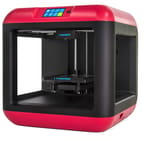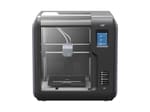Here we are then, 3 years down the road from the launch of the Toybox 3D printer, finally getting around to writing about it.
Once upon a time, it didn’t factor much into our planning – a side-show dropped at the expense of bigger, more serious 3D printers. Truth be told, we never really felt convinced by the Toybox. It seemed a bit gimmicky, a bit of a fad, one of those short-term things that wouldn’t be around for long. The 3D printing equivalent of Pogs, if you like. But, some 1,000 days down the line its popularity seems to be on the rise if anything, so here we are.
The Toybox began its rise with a successful Indiegogo campaign and an appearance on the hit TV show “Shark Tank”, where, in 2019, its founders attempted to convince some very successful business people to invest in the Toybox, and succeeded. Kevin O’Leary, a Canadian businessman who goes by the moniker of “Mr. Wonderful” felt so confident in the project that he threw in $150,000 for 13% equity.
So, what we have here is a curious, ultra-compact 3D printer with a 70 x 80 x 90 mm print volume that puts all the control into your children’s hands (uh oh…) via a supposedly nifty app. Could this be the perfect gateway into the world of 3D printing for your technologically curious cub?
Features

Designed For Kids
This is the real selling point of the Toybox. This machine has been designed for kids to be able to operate themselves (under supervision, of course) and shouldn’t need any tweaking, modifications, or even a slicer to prepare the 3D models for printing.
For a small person to be able to use this machine, they need a control method they’ll understand. That means there’s an app. Using this app, your child has a few options for the Toybox. They can select an existing model and tell it to print, modify a model already uploaded onto the app and even create something of their own. Then, it’s just a matter of pressing print.
The App
The application for the Toybox is really the core feature of the product. It’s supposed to be simple to search for and then print the items (toys, really) you want and has been designed, of course, to be operated by a small person with limited experience of, well, everything.
Files on the app for toys are arranged into a series of categories and collections such as “Critters” or “Quick Prints” as well as there being a section each for featured designs and the most popular designs. There’s also a system for drawing directly in the app, then sending the doodle to the Toybox to be printed.
For any of this to work, you need a Wi-Fi connection. The Toybox is Wi-Fi enabled so there shouldn’t be any issues here, but if you have patchy internet then there could be potential for some frustration. We haven’t tested the Toybox, and it isn’t immediately clear to us whether or not the printer needs to be tethered to your smartphone to function, but you can use your computer to browse toys online and schedule prints too. Providing that the Toybox servers are up, we assume everything will work just fine. But, we can’t help but wonder, what if the company disappeared one day? Would the printer still function correctly?
With the app forming such an integral part of the usability of this machine, it is absolutely vital that it works as advertised, as it could prove a real headache if it doesn’t. Apps like this, in our experience, can be very hit or miss.
In-app Currency
As with any modern, digital service that has to appeal to children nowadays. There are premium features that can only be obtained using Toybox’s in-app currency, Bolts. You have to buy Bolts separately before spending them, and 1400 of them will set you back around $10. How much that’ll get you is dependent on the cost of the desired “premium” toy. This is the only way to gain access to those premium models, not that they constitute a lot of the overall selection.
At one point in time there were “Play Pack” subscription models, which gave access to more sophisticated toys that needed a bit of putting together and additional, non-printed parts, but at the time of writing, they are not available and there’s no apparent scheduled date for return.
Build Area
Like children, the build volume of the Toybox is really quite small. There’s just 70 x 80 x 90 mm to play with here, but that’s probably okay for the role this printer has to play. Large prints take many hours, and children have but a fraction of the patience of a peckish terrier, meaning that by the time something substantial has printed, they’re unlikely to care anymore and will instead be focused on telling you about a green bus they saw.
It’s a very, very small build area, yes, but you have to assume that this is limited by the patience of children more than anything else. And there is an upside to this too.
Low Weight
The Toybox 3D printer weighs in at around 3 kg, meaning that that’s easy to store and keep out of the way of kids when you don’t want them using it.
Environmentally Respectful?
It’s not exactly environmentally friendly to be printing off tons of plastic toys all the time, but the only plastic you’ll really be using with the Toybox is PLA. It’s made from plants and Toybox will tell you that it’s compostable but that isn’t strictly true, it’s not a biodegradable material and if you pop it in your compost heap at home, not a lot will happen. You need industrial facilities to break this stuff down.
On the upside, PLA is one of the safer filaments to use at home. Now, you probably won’t want to see a PLA object in the mouth of your child all day, and bacteria does build up in 3D printed “pores”, but it’s not as harmful as many other filaments out there.
Uploading and Printing Files
You don’t just have to print from the catalog found on the Toybox app, you can also import files to your Toybox as long as they match the file requirements (they should be STL, OBJ, or G-code), meaning you’re not just limited to the items on the Toybox application.
This is done using the app, by getting into the Creator Space section and importing the relevant file. Once you upload your file to the Toybox app, it is sliced automatically online, and from there you can move it around the print bed, rotate it and scale it just as you would on a slicer such as Cura. After that, you can just press print.

Price
The Toybox 3D printer will set you back around $350. At the time of writing, you can get the Toybox printer for just $299, with a “Deluxe Pack” that bundles eight spools of filament (tweely referred to as “Printer Food” by Toybox) priced at $349.
It’s certainly not cheap for a small, material-limited 3D printer, and it certainly won’t be the last toy you ever buy, as some of the marketing material suggests. Still, it doesn’t seem a great leap for what could be a complete child-friendly 3D printer, especially if it really does work as simply as advertised. We haven’t used one, though, so we can’t say with certainty.

Reviews
There are a lot of positive reviews and comments surrounding the Toybox, with parents seemingly very impressed with its ease of use and versatility. Plenty commented on how it appears to be healthy and fun for children to be involved in a creative process as well as learning about an upcoming technology such as 3D printing.
With so many parents giving it a thumbs up, it’s clear to see that Toybox’s creators are onto something, though some criticism over the functionality of the app can be found in a few places, and given how crucial that is to the functionality of the machine, it’s easy to see how it might cause frustration.

Tech Specs
General Specifications
- Technology: Fused deposition modeling (FDM)
- Year: 2018
- Assembly: Assembled
- Mechanical arrangement: Cartesian XY-head
- Manufacturer: Toybox
3D Printer Properties
- Build volume: 70 x 80 x 90 mm
- Feeder system: Bowden
- Print head: Single nozzle
- Nozzle size: 0.4 mm
- Max. hot end temperature: N/A
- Max. heated bed temperature: No heated bed
- Print bed material: Toybox “Easy-Peel” bed
- Frame: N/A
- Bed leveling: N/A
- Connectivity: Wi-Fi
- Print recovery: No
- Filament sensor: No
- Camera: No
Materials
- Filament diameter: 1.75 mm
- Third-party filament: Yes
- Filament materials: PLA only
Software
- Recommended slicer: N/A
- Operating system: Windows, iOS, any web browser
- File types: STL, OBJ, gCode (via Creator Space on app)
Dimensions and Weight
- Frame dimensions: 188 x 188 x 230 mm
- Weight: 3 kg

Similar Printers
Err, well, this is where it gets a little tricky as there really isn’t much out there that’s like the Toybox 3D printer. Here’s a couple of alternatives that come close though.
Flashforge Finder
The Flashforge Finder could be considered an alternative to the Toybox, but it doesn’t have the easy-to-use app system that the Toybox does, meaning this printer is really better suited to children on the verge of becoming grown-up. Yes, we’re talking about the dreaded teenager. Good luck with that.
Really, this is a printer for a slightly higher age than the Toybox’s target market, but teens will probably prefer this over the Toybox.
Monoprice MP Voxel
Again, only really suitable for teenagers and adults, the Monoprice MP Voxel, like the Flashforge Finder, is a more advanced piece of kit than the Toybox, but does not have the usability of the app that lets kids maintain all the control. That being said, if it has got to the point where your child is old enough and responsible enough to handle a machine (and a slicer) like this, then we think this could be a good path to go down.
License: The text of "Toybox 3D Printer: Specs, Price, Release & Reviews" by All3DP is licensed under a Creative Commons Attribution 4.0 International License.
CERTAIN CONTENT THAT APPEARS ON THIS SITE COMES FROM AMAZON. THIS CONTENT IS PROVIDED ‘AS IS’ AND IS SUBJECT TO CHANGE OR REMOVAL AT ANY TIME.



